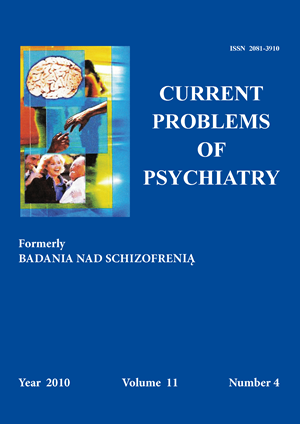Mental disintegration – chosen conceptions
Keywords:
psychotic disorder, mental disintegrationAbstract
The idea of disintegration is not to be found in any of the official classifications of mental disorders. Yet, it is closely connected with how their nature is understood and explained. In each case mental disorders are manifested by giving up fairly harmonious ways of tackling tasks and satisfying needs and difficulty overcoming crises and breakdowns. In psychotic states disorientation and disintegration become so difficult to bear that the patients often develop logical and consistent system of delusions enabling them to regain the feeling of living in somehow ordered world. In the theory of Mahler the element characteristic of personality development disorders is separation and denial of the real feelings in order to prevent suffering. In this situation the false ego: a schizoid, oral, symbiotic or narcisstic character, is developed. Neuroses, which from the Freudian times were perceived as a result of the internal mental conflict, are a milder symptom of mental disintegration. An interesting theory of understanding the nature of neuroses is proposed by Terruwe and Baars. It is based on the tomistic conception of the human nature where the emotional life is normally directed and driven by the intellect. According to them the superego is not the suppressive factor as Freud claimed but rather a different feeling pointed towards some goal which acts in a compulsive way and makes the intellectual control of the suppressed feeling impossible. Kazimierz Dąbrowski`s theory of positive disintegration emphasizes the developmental and creative aspects of disintegration as a stage in the process in which the higher and more complex structure is emerging. The global secondary integration, characterized by autonomy, authenticity, consciousness and self- consciousness, empathy and above all dynamism of the personality ideal as the strongest factor, is the highest level of mental development.
References
1. Antonovsky A., Poczucie koherencji jako determinanta zdrowia. W: Heszen-Niejodek I., Sęk H. red., Psychologia zdrowia. Warszawa: 1997, s. 206 -231.
2. Freud Z. Człowiek, religia, kultura. Warszawa: 1967.
3. Sęk H. Wybrane psychodynamiczne teorie funkcjonowania jednostki i grupy oraz mechanizmy zaburzeń. W: Sęk H. red., Społeczna psychologia kliniczna. Warszawa: 2000, s. 43-69.
4. Siek S.Wybrane metody badania osobowości. Warszawa: 1983.
5. Kępiński A. Schizofrenia. Warszawa: 1979.
6. Laing R. Podzielone „ja”. Poznań: 1999.
7. Mahler M., Pine R., Bergman A. The psychological birth of the human infant. New York: 1975.
8. Johnson S. Przemiana charakterologiczna. Cud ciężkiej pracy. Warszawa: 1993.
9. Goldstein E. Zaburzenia z pogranicza. Gdańsk: 2003.
10. Freud Z. Wstęp do psychoanalizy. Warszawa: 1984.
11. Terruwe A., Baars C. Integracja psychiczna. Poznań: 1987.
12. Dąbrowski K. Trud istnienia. Warszawa: 1986.


